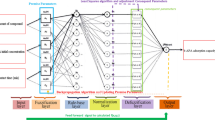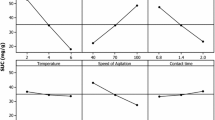Abstract
The present study investigated the removal efficiency of Reactive Red 120 (RR120) using biochar produced from a seaweed Ulva reticulata using the predictive models namely Response Surface Methodology (RSM) and Adaptive Neuro-Fuzzy Inference System (ANFIS). The experiments were conducted in both batch and continuous processes, and the coded variables namely biochar dose, pH, Initial RR120 concentration, and temperature were studied for batch process, and the coded variables namely sorbent depth, solute flowrate, and initial RR120 concentration were studied for the continuous process. The correlation coefficient of the RSM and ANFIS for the batch process was obtained as 0.9977 and 0.9999. Similarly, for the continuous process, the correlation coefficient of 0.9979 and 0.9997 was obtained for RSM and ANFIS. Further statistical error analysis was conducted to find the goodness of the model with the experimental values. A comparison study was arrived based on the cluster analysis of experimental, RSM, and ANFIS models. The results concluded that the ANFIS model was superior to RSM in the prediction of the removal efficiency of the Reactive Red 120.
Graphical abstract


















Similar content being viewed by others
References
Abdolali A, Guo WS, Ngo HH, Chen SS, Nguyen NC, Tung KL (2014) Typical lignocellulosic wastes and by-products for biosorption process in water and wastewater treatment: a critical review. Bioresour Technol 160:57–66. https://doi.org/10.1016/j.biortech.2013.12.037
Anirudhan TS, Ramachandran M (2015) Adsorptive removal of basic dyes from aqueous solutions by surfactant modified bentonite clay (organoclay): kinetic and competitive adsorption isotherm. Process Saf Environ Prot 95:215–225. https://doi.org/10.1016/j.psep.2015.03.003
Fegousse A, El Gaidoumi A, Miyah Y et al (2019) Pineapple bark performance in dyes adsorption: optimization by the central composite design. J Chemother 2019:1–11. https://doi.org/10.1155/2019/3017163
Franca AS, Oliveira LS, Ferreira ME (2009) Kinetics and equilibrium studies of methylene blue adsorption by spent coffee grounds. Desalination. 249:267–272. https://doi.org/10.1016/j.desal.2008.11.017
Yagub MT, Sen TK, Afroze S, Ang HM (2014) Dye and its removal from aqueous solution by adsorption: a review. Adv Colloid Interf Sci 209:172–184
Ferreira AM, Coutinho JAP, Fernandes AM, Freire MG (2014) Complete removal of textile dyes from aqueous media using ionic-liquid-based aqueous two-phase systems. Sep Purif Technol 128:58–66. https://doi.org/10.1016/j.seppur.2014.02.036
Gupta N, Kushwaha AK, Chattopadhyaya MC (2016) Application of potato (Solanum tuberosum) plant wastes for the removal of methylene blue and malachite green dye from aqueous solution. Arab J Chem 9:S707–S716. https://doi.org/10.1016/j.arabjc.2011.07.021
Saleh TA, Gupta VK (2012) Photo-catalyzed degradation of hazardous dye methyl orange by use of a composite catalyst consisting of multi-walled carbon nanotubes and titanium dioxide. J Colloid Interface Sci 371:101–106. https://doi.org/10.1016/j.jcis.2011.12.038
Kharat DS (2015) Preparing agricultural residue-based adsorbents for removal of dyes from effluents - A review. Brazilian J Chem Eng 20(1):1–12. https://doi.org/10.1590/0104-6632.20150321s00003020
Lehmann J, Joseph S (2009) Biochar for environmental management: an introduction. In: Biochar for Environmental Management: Science and Technology. Earthscan, London, pp 1–12. https://doi.org/10.4324/9781849770552
Liu Y, Liu YJ (2008) Biosorption isotherms, kinetics and thermodynamics. Sep Purif Technol 61(3):229–242. https://doi.org/10.1016/j.seppur.2007.10.002
Beesley L, Moreno-Jiménez E, Gomez-Eyles JL, Harris E, Robinson B, Sizmur T (2011) A review of biochars’ potential role in the remediation, revegetation and restoration of contaminated soils. Environ Pollut 159:3269–3282
Moghaddam MG, Khajeh M (2011) Comparison of response surface methodology and artificial neural network in predicting the microwave-assisted extraction procedure to determine zinc in fish muscles. Food Nutr Sci 02:803–808. https://doi.org/10.4236/fns.2011.28110
Isoda N, Rodrigues R, Silva A, Gonçalves M, Mandelli D, Figueiredo FCA, Carvalho WA (2014) Optimization of preparation conditions of activated carbon from agriculture waste utilizing factorial design. Powder Technol 256:175–181. https://doi.org/10.1016/j.powtec.2014.02.029
Deb A, Debnath A, Saha B (2020) Ultrasound-aided rapid and enhanced adsorption of anionic dyes from binary dye matrix onto novel hematite/polyaniline nanocomposite: response surface methodology optimization. Appl Organomet Chem. https://doi.org/10.1002/aoc.5353
Ohale PE, Uzoh CF, Onukwuli OD (2017) Optimal factor evaluation for the dissolution of alumina from Azaraegbelu clay in acid solution using RSM and ANN comparative analysis. South African J Chem Eng 24:43–54. https://doi.org/10.1016/j.sajce.2017.06.003
Gonzalez del Cerro RT, Subathra MSP, Manoj Kumar N et al (2020) Modelling the daily reference evapotranspiration in semi-arid region of South India: a case study comparing ANFIS and empirical models. Inf Process Agric 8:173–184. https://doi.org/10.1016/j.inpa.2020.02.003
Robic A, Rondeau-Mouro C, Sassi JF, Lerat Y, Lahaye M (2009) Structure and interactions of ulvan in the cell wall of the marine green algae Ulva rotundata (Ulvales, Chlorophyceae). Carbohydr Polym 77:206–216. https://doi.org/10.1016/j.carbpol.2008.12.023
Kumar M, Gokulan R, Sujatha S, Shanmuga Priya SP, Praveen S, Elayaraja S (2021) Biodecolorization of Reactive Red 120 in batch and packed bed column using biochar derived from Ulva reticulata. Biomass Convers Biorefin. https://doi.org/10.1007/s13399-020-01268-x
Zaghloul MS, Hamza RA, Iorhemen OT, Tay JH (2020) Comparison of adaptive neuro-fuzzy inference systems (ANFIS) and support vector regression (SVR) for data-driven modelling of aerobic granular sludge reactors. J Environ Chem Eng 8:103742. https://doi.org/10.1016/j.jece.2020.103742
Jaafari J, Yaghmaeian K (2019) Response surface methodological approach for optimizing heavy metal biosorption by the blue-green alga chroococcus disperses. Desalin Water Treat 142:225–234. https://doi.org/10.5004/dwt.2019.23406
Mazaheri H, Ghaedi M, Ahmadi Azqhandi MH, Asfaram A (2017) Application of machine/statistical learning, artificial intelligence and statistical experimental design for the modeling and optimization of methylene blue and Cd(ii) removal from a binary aqueous solution by natural walnut carbon. Phys Chem Chem Phys 19:11299–11317. https://doi.org/10.1039/c6cp08437k
Taran M, Aghaie E (2015) Designing and optimization of separation process of iron impurities from kaolin by oxalic acid in bench-scale stirred-tank reactor. Appl Clay Sci 107:109–116. https://doi.org/10.1016/j.clay.2015.01.010
Sodeifian G, Sajadian SA, SaadatiArdestani N (2016) Evaluation of the response surface and hybrid artificial neural network-genetic algorithm methodologies to determine extraction yield of Ferulago angulata through supercritical fluid. J Taiwan Inst Chem Eng 60:165–173. https://doi.org/10.1016/j.jtice.2015.11.003
Pilkington JL, Preston C, Gomes RL (2014) Comparison of response surface methodology (RSM) and artificial neural networks (ANN) towards efficient extraction of artemisinin from Artemisia annua. Ind Crop Prod 58:15–24. https://doi.org/10.1016/j.indcrop.2014.03.016
Vijayaraghavan K, Yun YS (2008) Competition of Reactive red 4, Reactive orange 16 and Basic blue 3 during biosorption of Reactive blue 4 by polysulfone-immobilized Corynebacterium glutamicum. J Hazard Mater 153:478–486. https://doi.org/10.1016/j.jhazmat.2007.08.079
Aksu Z, Çaǧatay ŞŞ (2006) Investigation of biosorption of Gemazol Turquise Blue-G reactive dye by dried Rhizopus arrhizus in batch and continuous systems. Sep Purif Technol 48:24–35. https://doi.org/10.1016/j.seppur.2005.07.017
Joglekar A, May A (1987) Product excellence through design of experiments. Cereal Foods World 32:857–868
Author information
Authors and Affiliations
Corresponding authors
Additional information
Publisher’s Note
Springer Nature remains neutral with regard to jurisdictional claims in published maps and institutional affiliations.
Rights and permissions
About this article
Cite this article
Lenin Sundar, M., Kalyani, G., Gokulan, R. et al. Comparative adsorptive removal of Reactive Red 120 using RSM and ANFIS models in batch and packed bed column. Biomass Conv. Bioref. 13, 5843–5859 (2023). https://doi.org/10.1007/s13399-021-01444-7
Received:
Revised:
Accepted:
Published:
Issue Date:
DOI: https://doi.org/10.1007/s13399-021-01444-7




